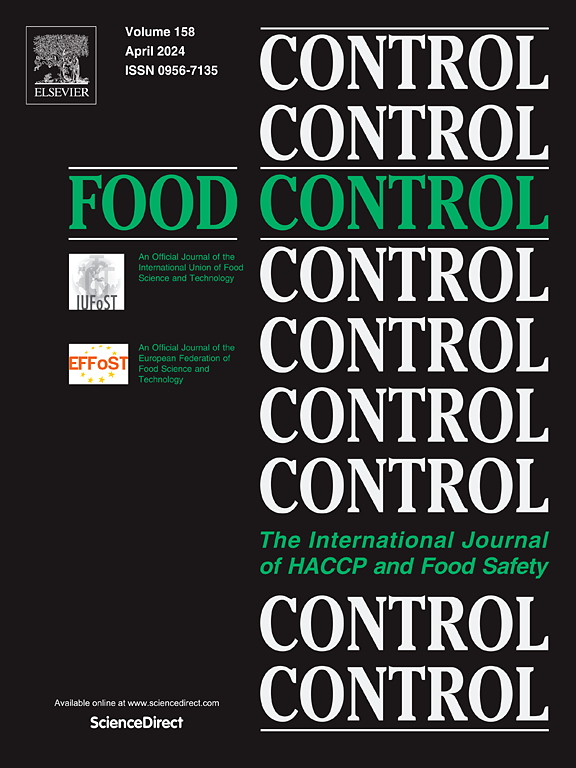在猪肉香肠供应链中实施基于应用程序的时间-温度-指示器系统,用于实时预测保质期
IF 5.6
1区 农林科学
Q1 FOOD SCIENCE & TECHNOLOGY
引用次数: 0
摘要
时间-温度-指标(TTIs)与预测模型相结合,是避免食品供应链上日益增多的食品浪费和相关资源浪费的有用工具。由于缺乏用于实时预测保质期的数字技术,这些系统在实践中的成功实施仍然缺失。本研究旨在验证为数字读取 OnVu™ TTIs 和预测生猪香肠供应链中易腐产品的保质期而开发的新型应用系统。因此,根据微生物参数开发了生猪肉肠的保质期动力学模型。根据应用测量的 TTI 数据开发了动态 TTI 模型,并在实验室规模上进行了验证,为试点研究做准备。在试验研究中,基于应用测量的 TTIs 保质期预测在实际条件下得到了验证。结果表明,基于应用程序颜色测量的 OnVu™ TTI 动力学一般可以反映生猪肉肠的腐败动力学。试验研究表明,该应用程序预测的 TTI 颜色值与测量值非常一致,准确系数为 1.02-1.03;但是,保质期的细微差异表明,必须通过整合更多数据来进一步改进预测模型。虽然根据 TTI 应用程序测量结果预测的保质期与生猪肉香肠的实际保质期在小时范围内存在差异,但由于该研究表明 TTI 和产品动力学具有很高的可比性,因此可以证明该应用程序在保质期预测方面的通用性。对应用程序进行进一步的技术调整和充电时间的调整可能会进一步改善应用程序在生猪肉肠供应链中的保质期预测。本文章由计算机程序翻译,如有差异,请以英文原文为准。
Implementation of an app-based time-temperature-indicator system for the real-time shelf life prediction in a pork sausage supply chain
Time-temperature-indicators (TTIs) combined with predictive modeling are helpful tools for avoiding the increasing amount of food waste and the associated waste of resources along the food supply chain. Successful implementation of these systems in practice is still absent due to missing digital technologies for real-time shelf life prediction. This study aimed to validate a novel app system developed for the digital read-out of OnVu™ TTIs and the shelf life prediction of perishable products along the raw pork sausage supply chain. Therefore, a kinetic shelf life model of raw pork sausage was developed based on microbial parameters. A dynamic TTI model was developed based on app-measured TTI data and validated on a laboratory scale to prepare for the pilot study. In the pilot study, the shelf life prediction of TTIs based on app measurements was validated under practical conditions. Results showed that the spoilage kinetics of raw pork sausage could, in general, be reflected by the OnVu™ TTI kinetics based on the app's color measurements. The pilot study showed that predicted and measured TTI color values by the app were in good agreement with accuracy factors of 1.02–1.03; however, slight differences in shelf lives revealed that the prediction model must be further improved by integrating more data. Although variances in the hourly range could be seen between the predicted shelf life based on TTI app measurements and the real shelf life of raw pork sausage, the study serves as a proof of concept for the general useability of the app for shelf life prediction because it showed that TTI and product kinetics were highly comparable. Further technical adjustments to the app and the adaptation of the charging time may further improve the shelf life prediction by the app along the raw pork sausage supply chain.
求助全文
通过发布文献求助,成功后即可免费获取论文全文。
去求助
来源期刊

Food Control
工程技术-食品科技
CiteScore
12.20
自引率
6.70%
发文量
758
审稿时长
33 days
期刊介绍:
Food Control is an international journal that provides essential information for those involved in food safety and process control.
Food Control covers the below areas that relate to food process control or to food safety of human foods:
• Microbial food safety and antimicrobial systems
• Mycotoxins
• Hazard analysis, HACCP and food safety objectives
• Risk assessment, including microbial and chemical hazards
• Quality assurance
• Good manufacturing practices
• Food process systems design and control
• Food Packaging technology and materials in contact with foods
• Rapid methods of analysis and detection, including sensor technology
• Codes of practice, legislation and international harmonization
• Consumer issues
• Education, training and research needs.
The scope of Food Control is comprehensive and includes original research papers, authoritative reviews, short communications, comment articles that report on new developments in food control, and position papers.
 求助内容:
求助内容: 应助结果提醒方式:
应助结果提醒方式:


